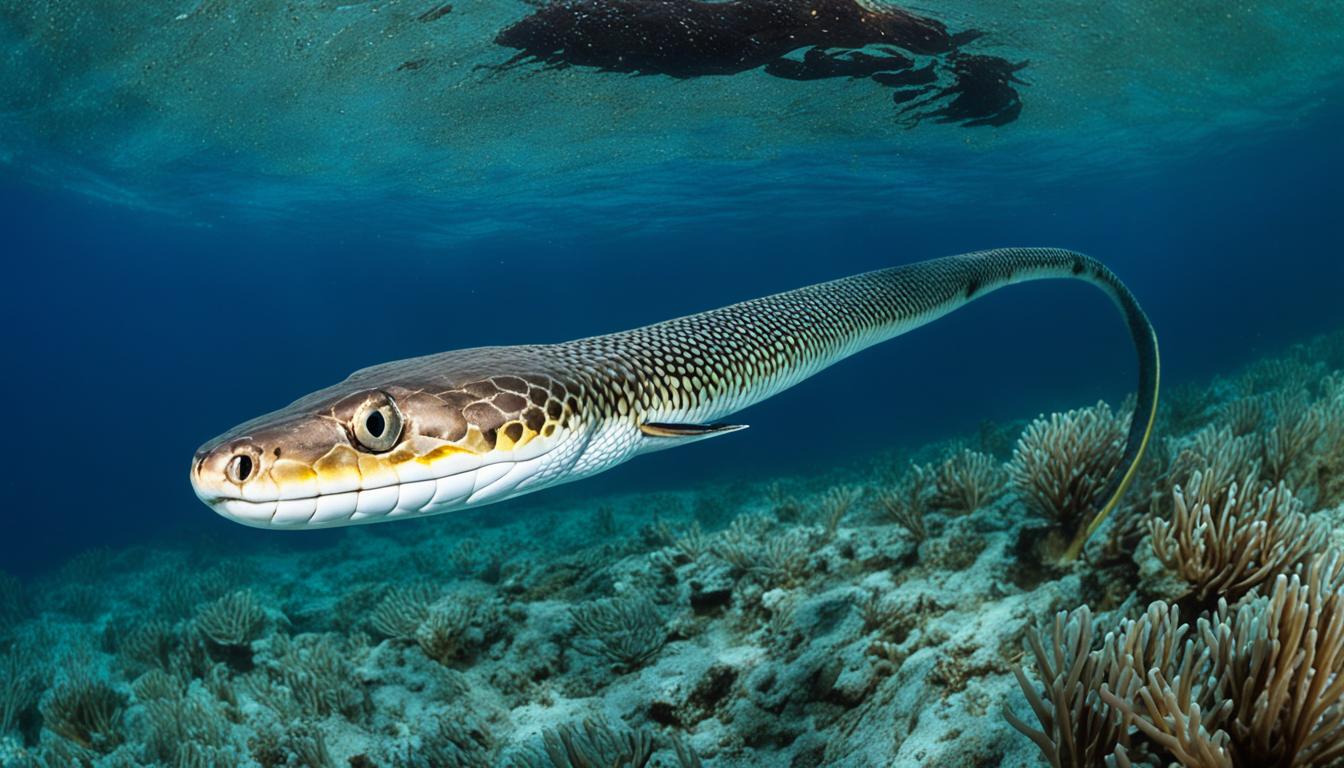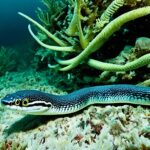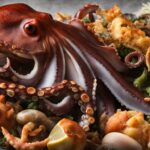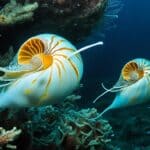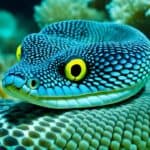Ever curious about how sea snakes find their meals underwater? These marine reptiles have a special way of hunting that stands out in the ocean. They use predatory behavior that’s unique to them. By learning how they hunt, we can better understand their role in the ocean.
Sea snakes have special skills to find and catch their food underwater. This makes them stand out as skilled hunters in the sea.
Introduction to Sea Snakes and Their Hunting Habits
Sea snakes live in a world full of variety, showing how they’ve adapted to different places. They have special traits that help them hunt in various sea snake homes, mainly in warm and tropical areas.
Overview of sea snake species and habitats
There are over 30 types of sea snakes in the family Hydrophiidae. Each one likes different places, from the coast to the deep sea. For instance, the Yellow-bellied Sea Snake loves open waters, thanks to its special traits.
The variety in sea snake homes shows how they fit into their environments. Each type plays a key role in their ecosystem, helping them survive and find food.
Evolutionary adaptations for aquatic life
Sea snakes have changed a lot over time to live in the water. Their bodies are shaped for swimming better. They can hold their breath for a long time and see well under water.
These changes show how important evolution is for sea snakes to hunt. They use their special senses to find food underwater.
How do sea snakes hunt for food?
Sea snakes have developed unique ways to find food underwater. They use their senses and know their surroundings to hunt. This helps them survive in the ocean.
Mechanisms of prey detection underwater
Sea snakes use different ways to find their prey. They can see fish clearly in the water. But they also feel vibrations to find fish far away. This mix of senses makes them good hunters in many ocean places.
The role of chemical cues in hunting
Sea snakes also use smell to hunt. They stick out their tongues to pick up scents in the water. Then, they send these smells to a special organ inside their mouth. This helps them find food, even when they can’t see well.
Some sea snakes prefer certain types of fish. They use smell to find these fish. This is very important when the water is cloudy.
| Detection Method | Description |
|---|---|
| Visual Detection | Utilizes sight to spot moving prey in clear waters. |
| Vibration Sensitivity | Perceives water vibrations to identify the presence of fish. |
| Chemical Cues | Uses scent particles for locating prey, even in low visibility. |
Common Hunting Techniques Used by Sea Snakes
Sea snakes have fascinating hunting techniques that show their skill in the water. They use ambush strategies and precise attacks to catch their prey. These methods highlight their adaptability and hunting prowess.
Ambush and stealthy approaches
Sea snakes wait motionless near the surface, blending in with their surroundings. This ambush tactic often catches fish off guard. Their colors help them stay hidden until they strike.
Strategies for attacking prey
When attacking, sea snakes are fast and agile. They use quick mouth swipes to catch their prey. This shows their intelligence and ability to adapt to their prey’s moves. Their hunting combines stealth and aggression effectively.
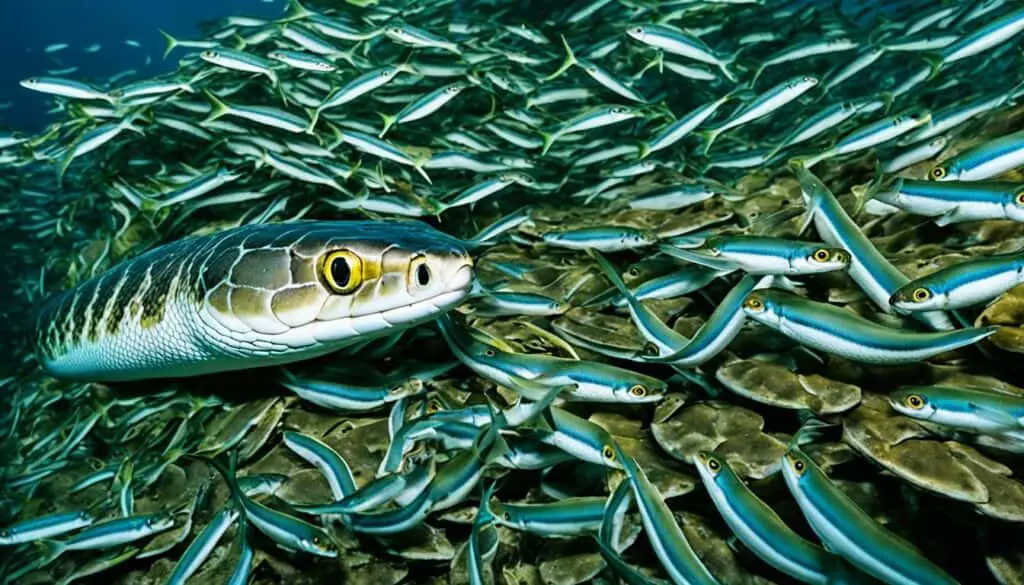
| Hunting Technique | Description | Benefits |
|---|---|---|
| Ambush Strategy | Waits for prey to come close without movement. | Enhances camouflage and surprise. |
| Stealth Approach | Slow, careful movements to avoid detection. | Increases chances of surprise capture. |
| Lateral Swipes | Quick strikes from the sides during an attack. | Allows capture from various angles. |
| Adaptive Strategies | Modifies approach based on prey behavior. | Maximizes success rates in hunting. |
Sea Snake Diet and Preferred Prey Types
Sea snakes have diverse diets, reflecting their species variety. They mainly eat fish, adjusting their diet to their surroundings. Knowing what they eat helps us understand their role in the ocean.
General feeding habits of different species
Sea snakes have different ways of hunting. Some eat many types of fish, while others stick to certain ones. For example, some sea snakes catch fast fish with great speed. Others eat fish from specific places, making their diets vary by location.
Specific prey preferences, such as fish and fish eggs
Many sea snakes love to eat fish and fish eggs. The turtle-headed sea snake is known for eating fish eggs. This shows how they use different food sources to survive. Their eating habits affect how they hunt and interact with other sea creatures.
| Species | Feeding Habits | Preferred Prey |
|---|---|---|
| Hydrophis platurus | Generalist, agile | Small fish, fish eggs |
| Lapemis hardwickii | Specialist, ambush | Eels, larger fish |
| Aipysurus laevis | Focused on fish eggs | Fish eggs, small fish |
This look at their eating habits shows how sea snakes live in different ocean areas. Their ability to adapt shows the ocean’s complex food web and their important role in it.
Impact of Environmental Factors on Hunting Behavior
Environmental factors greatly shape the hunting ways of sea snakes. Things like water temperature, ocean currents, and underwater structures affect how they find and catch prey. For example, the right water temperature can make sea snakes and their prey more active, setting the best times for hunting.
Seasonal changes or disturbances can also change how much prey is around. This makes sea snakes change their hunting ways. They might use ambush tactics or look for new places to hunt. Knowing how they adapt is key to understanding their role in their ecosystems.
Knowing about these changes is crucial for saving their homes. By understanding how changes in the ocean affect sea snakes, we can protect them better. This helps keep the balance of life under the sea.
FAQ
How do sea snakes detect their prey?
Sea snakes find prey using both sight and smell. They taste the water with their forked tongues, then analyze the scents in their vomeronasal organs.
What are the primary hunting techniques employed by sea snakes?
Sea snakes often hide still, blending in with their surroundings. They might move slightly to draw fish closer before striking fast.
What is the diet of sea snakes?
Sea snakes mainly eat fish. Some eat specific fish like eels or fish eggs. This lets them live in different marine places.
How do environmental factors affect sea snakes’ hunting behavior?
Things like water temperature, currents, and fish numbers change how sea snakes hunt. They adjust their hunting to fit these changes.
What adaptations do sea snakes have for life in the water?
Sea snakes have a slim body, a special breathing system for staying underwater, and better senses. This helps them hunt well in the water.
Which types of fish are common prey for sea snakes?
Sea snakes eat many fish types. Some prefer fish eggs or bigger fish, based on what they like to eat.
How do sea snakes strike their prey?
Sea snakes catch prey with fast side swipes of their mouths. They change how they attack based on the fish’s behavior.
Source Links
- https://www.nhm.ac.uk/discover/sea-snakes-sea-kraits-and-their-aquatic-adaptations.html
- https://bioone.org/journals/zoological-science/volume-35/issue-6/zs180059/How-Snakes-Find-Prey-Underwater–Sea-Snakes-Use-Visual/10.2108/zs180059.full
- https://australian.museum/learn/animals/reptiles/yellow-bellied-sea-snake/

